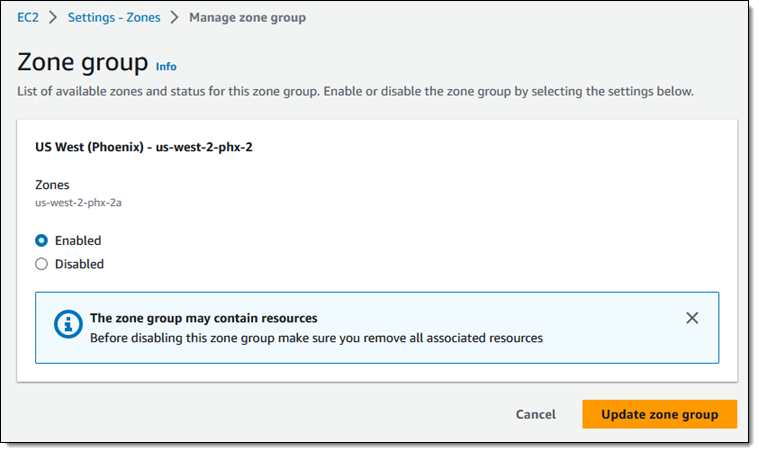AWS News Blog
New: AWS Local Zone in Phoenix, Arizona – More Instance Types, More EBS Storage Classes, and More Services
|
|
I am happy to announce that a new AWS Local Zone in Phoenix, Arizona is now open and ready for you to use, with more instance types, storage classes, and services than ever before.
We launched the first AWS Local Zone in 2019 (AWS Now Available from a Local Zone in Los Angeles) with the goal of making a select set of EC2 instance types, EBS volume types, and other AWS services available with single-digit millisecond when accessed from Los Angeles and other locations in Southern California. Since then, we have launched a second Local Zone in Los Angeles, along with 15 more in other parts of the United States and another 17 around the world, 34 in all. We are also planning to build 19 more Local Zones outside of the US (see the Local Zones Locations page for a complete list).
Local Zones In Action
Our customers make use of Local Zones in many different ways. Popular use cases include real-time gaming, hybrid migrations, content creation for media & entertainment, live video streaming, engineering simulations, and AR/VR at the edge. Here are a couple of great examples that will give you a taste of what is possible:
Arizona State University (ASU) – Known for its innovation and research, ASU is among the largest universities in the U.S. with 173,000 students and 20,000 faculty and staff. Local Zones help them to accelerate the delivery of online services and storage, giving them a level of performance that is helping them to transform the educational experience for students and staff.
DISH Wireless -Two years ago they began to build a cloud-native, fully virtualized 5G network on AWS, making use of Local Zones to support latency-sensitive real-time 5G applications and workloads at the network edge (read Telco Meets AWS Cloud to learn more). The new Local Zone in Phoenix will allow them to further enhance the strength and reliability of their network by extending their 5G core to the edge.
We work closely with these and many other customers to make sure that the Local Zone(s) that they use are a great fit for their use cases. In addition to the already-strong set of instance types, storage classes, and services that are part-and-parcel of every Local Zone, we add others on an as-needed basis.
For example, Local Zones in Los Angeles, Miami, and other locations have additional instance types; several Local Zones have additional Amazon Elastic Block Store (Amazon EBS) storage classes, and others have extra services such as Application Load Balancer, Amazon FSx, Amazon EMR, Amazon ElastiCache, Amazon Relational Database Service (RDS), Amazon GameLift, and AWS Application Migration Service (AWS MGN). You can see this first-hand on the Local Zones Features page.
And Now, Phoenix
As I mentioned earlier, this Local Zone has more instance types, storage classes, and services than earlier Local Zones. Here’s what’s inside:
Instance Types – Compared to all other Local Zones with the T3, C5(d), R5(d), and G4dn instance types, the Phoenix Local Zone includes C6i, M6i, R6i, and Cg6n instances.
EBS Volume Types – In addition to the gp2 volumes that are available in all Local Zones, the Phoenix Local Zone includes gp3 (General Purpose SSD) , io1 (Provisioned IOPS SSD) , st1 (Throughput Optimized HDD), and sc1 (Cold HDD) storage.
Services – In addition to Amazon Elastic Compute Cloud (Amazon EC2), Amazon Elastic Block Store (Amazon EBS), AWS Shield, Amazon Virtual Private Cloud (Amazon VPC), Amazon Elastic Container Service (Amazon ECS). Amazon Elastic Kubernetes Service (Amazon EKS), Application Load Balancer, and AWS Direct Connect, the Phoenix LZ includes NAT Gateway.
Pricing Models – In addition to On-Demand and Savings Plans, the Phoenix Local Zone includes Spot.
Going forward, we plan to launch more Local Zones that are similarly equipped.
Opting-In to the Phoenix Local Zone
The original Phoenix Local Zone was launched in 2022 and remains available to customers who have already enabled it. The Zone that we are announcing today can be enabled by new and existing customers.
To get started with this or any other Local Zone, I must first enable it. To do this, I open the EC2 Console, select the parent region (US West (Oregon)) from the menu, and then click EC2 Dashboard in the left-side navigation:

Then I click on Zones in the Account attributes box:

Next, I scroll down to the new Phoenix Local Zone (us-west-2-phx-2), and click Manage:

I click Enabled, and then Update zone group:

I confirm that I want to enable the Zone Group, and click Ok:

And I am all set. I can create EBS volumes, launch EC2 instances, and make use of the other services in this Local Zone.
— Jeff;
